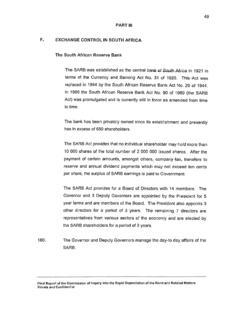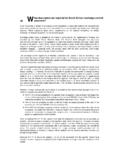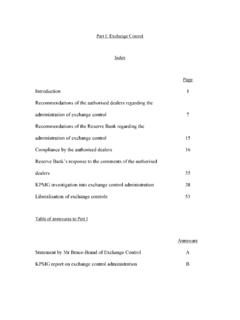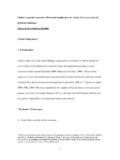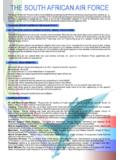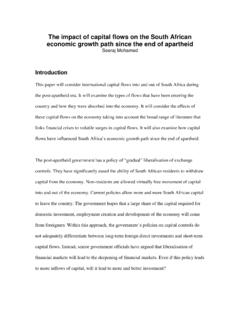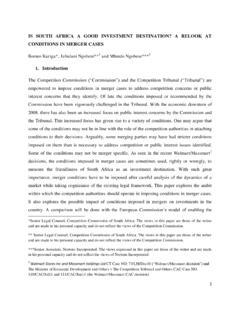Transcription of South Africa - OECD
1 South - Africa 10/01/02 15:12 Page 265. South Africa Pretoria key figures Land area, thousands of km2: 1 221. Population, thousands (2000): 43 309. GDP per capita, $ (2000): 2 907. Life expectancy (1995-2000): Illiteracy rate (2001): South - Africa 10/01/02 15:12 Page 266. South - Africa 10/01/02 15:12 Page 267. T EN YEARS AFTER APARTHEID ENDED, South Africa still slowdown of export growth. Given somewhat enhanced faces the challenges of reducing inequality and public capital expenditure programmes but moderate enhancing growth performance. The policies consumption dynamism, growth expectations for 2001. implemented so far have had somewhat limited results. and 2002 are at and per cent. Momentum In terms of growth, South Africa is still rebounding from gathered during the last two years of Ten years after apartheid the 1998 slowdown with a growth rate at per cent expansion remains fragile while social ended, South Africa still in 2000. The positive expectations remain precarious, cohesion remains a highly sensitive faces the challenges however, as the downturn in economic activity during issue.
2 High unemployment persists of reducing inequality 2001 in the OECD area could have a negative impact while the formal labour market records and enhancing growth on the South African economy. The rand is still further job losses and informal depreciating but at a slower pace, which implies a activities develop. Figure 1 - Real GDP Growth 10. 8. 6 267. 4. 2. 0. 1995 1996 1997 1998 1999 2000 2001(e) 2002(p). -2. -4. -6. -8. -10. Source: Authors' estimates and predictions based on South Africa Reserve Bank data. intermediation and transport and communications Recent Economic Developments sectors and by the sustained growth of retail trade after three years of moderate growth. The South African economy has slowly recovered through 1999 and 2000 after the contagion effect of Output growth in the secondary sectors firmed in the Asian crisis and the turmoil in the financial markets 2000. Manufacturing in particular has recovered thanks that hit the country during 1997 and 1998. Growth to net improvement in demand conditions, both at performance of 2000 can be explained by the steady the domestic level and in terms of export demand.
3 As increases of both the manufacturing and services sectors. a result of continuous rand depreciation in the last The ongoing depreciation of the rand has boosted the decade, the export oriented industries mainly manufacturing output that grew by per cent in chemicals, basic metals and transport equipment have 2000. The tertiary sector expanded throughout 2000 gained momentum and in ten years their share in the buoyed by continuous expansion of financial manufacturing sector has risen by around 10 per cent. OECD/AfDB 2002 African Economic Outlook South - Africa 10/01/02 15:12 Page 268. South Africa Figure 2 - GDP Per Capita in South Africa and in Africa ($ current). Africa South Africa 4500. 4000. 3500. 3000. 2500. 2000. 1500. 1000. 500. 0. 1990 1991 1992 1993 1994 1995 1996 1997 1998 1999 2000. Source: Authors' estimates based on IMF data. However, with an average rate of growth of 2 per cent impetus of the modest growth that has taken place in in the period 1995-2000 the manufacturing sector has the South African economy in the last five years.
4 Average not performed as expected. Structural issues such as the growth has been equal to per cent and sub-sectors regulatory framework in the labour and product market such as transport and communications as well as have hampered the sector's growth. Moreover, skill financial intermediation have expanded at a higher 268 shortages fuelled by the brain drain that has hit the pace. Prospects for 2002 are encouraging since the country in recent years has constrained the expansion government decision to allow a second fixed line of the industrial sector. operator for 2002 in the telecoms sector could further expand the dynamism of the sector. The tertiary sectors continued to expand significantly all through 2000. The buoyancy of the Real output in the agriculture sector increased commercial sector, helped by a boost in household markedly during 2000 thanks both to a prolific (even disposable income, made a solid contribution to such though late) harvest of the maize crop, which amounted growth.
5 This trend was further enhanced by the to one-third more than the previous year ( million dynamism in tourist activities and the expansion of tons instead of ), and to solid progress in livestock telecommunications, the cellular telephone and Internet and horticultural farming. Wheat production networks in particular. Services have been the major contributed as well with a volume increase of 24 per Table 1 - Demand Composition (percentage of GDP). 1995 1998 1999 2000 2001 (e) 2002 (p). Gross capital formation Public Private Consumption Public Private External sector Exports Imports Source: Authors' estimates and predictions based on South Africa Reserve Bank data. African Economic Outlook OECD/AfDB 2002. South - Africa 10/01/02 15:12 Page 269. South Africa Figure 3 - GDP by Sector in 2000. Other services Agriculture Government Mining and quarrying services 6% 3% 6%. 16%. Manufacturing 19%. 21% 3% Electricity and water Financial and 3%. business services Construction 13%. 10%.
6 Wholesale and Transport, storage retail trade and communications Source: Authors' estimates based on South Africa Reserve Bank data. Figure 4 - Sectoral Contribution to GDP Growth in 2000. Volume Price Value Agriculture Mining and quarrying Manufacturing 269. Electricity and water Construction Wholesale and retail trade Transport, storage and communications Finance and business services Government services Other services GDP at factor cost -2 0 2 4 6 8 10 12. Source: Authors' estimates based on South Africa Reserve Bank data. cent with respect to 1999. The shrinking of the mining After experiencing an almost flat trend in 1999, real output ( per cent in 2000) did not offset this good gross domestic expenditure picked up again in 2000, performance in agriculture. Gold production fell the taking over from exports to lead growth. All components most, counter-balancing increases in other sectors of domestic expenditure contributed to this higher notably platinum of the mining industry.
7 Path. OECD/AfDB 2002 African Economic Outlook South - Africa 10/01/02 15:12 Page 270. South Africa Gross capital formation displayed a growth rate of Employment And Redistribution (GEAR) strategy that per cent during 2000 after a steep decline due to was adopted in June 1996. One of the major objectives the 1998 slowdown. Both private and public sectors of GEAR was to enhance the credibility of the South contributed to this moderate upsurge of investment. African government by signalling to the international Nevertheless compared to other emerging investor community South Africa 's commitment to a economies South Africa is still characterised by stable macro policy. Moreover, the fiscal policy was relatively low levels of investment. Indeed, during the designed to solve the employment crisis through second half of the 1990s, investment languished at significant growth increases. Social and physical around 17 per cent of GDP. Public sector investment, infrastructure was considered as a main pillar for in particular, has not grown at a high pace in the last boosting economic growth and employment.
8 An five years despite government emphasis on the need for integrated policy aiming at containing real increases in public investment as a boost to economic growth. Since public salaries to 1 per cent per annum and increasing 1995, the growth of general government investment public capital expenditure by per annum was has been on average per cent and in 2000 it has envisaged in order to fund substantial housing, land been only per cent ( if parastatals are included). reform and infrastructural development programmes. The trend is again positive in 2001 and 2002, with In contrast with the GEAR proposals, the government public investment (including parastatals) growing at met its targets on fiscal deficit keeping a planned level a higher pace in 2001 and 2002. of expenditure with increasing spending on the government wage bill at the expense of capital Private consumption continued to expand, expenditure. Despite the fact that GEAR has been recovering further from the 1998 downturn and successful on fiscal balance target and inflation control, 270 reflecting the optimistic attitude of consumers.
9 Even growth has remained low while unemployment has if all major categories contributed to this higher path, continued to grow. durable and semi-durable goods have been the liveliest components. The expansion in household spending This has led to a major re-evaluation of government was largely grounded by the tax cuts and the decline growth strategy. In February 2001, President Thabo in bank lending rates that occurred all along 1999. As Mbeki argued in his state-of-the-nation address that a consequence, debt-servicing cost of households has major emphasis will be on creating the right diminished and real disposable income has risen by environment to expand the economy. Over the next per cent in 2000 compared with per cent in three years, government spending is presumed to grow 1999. Real government consumption continues its in real terms. In particular, a billion ($ billion negative trend started in 1998, reflecting the successful at the average exchange rate of 7 Rand per $) spending government policy to restrain spending and reduce the is expected on investment in infrastructure.
10 Additional budget deficit. The reduction of government spending R16 billion ($ billion) will be spent in favour of is nevertheless achieved through a decrease of spending people suffering from HIV/AIDS. R4 billion for goods and non-labour services. Therefore, a ($576 million) will be devoted to improving efficiency proportional increase of compensation for employees of the criminal justice system. On revenues, a tax cut has occurred. of billion ($ billion) is scheduled through a restructuring of personal income taxes affecting particularly the middle income class. Nevertheless, the Macroeconomic Policy government has remained committed to fiscal discipline. Indeed, privatisation receipts expected at R18 billion Fiscal and Monetary Policies ($ billion) for 2001-02 will be used to pay long- term domestic bond debt. Beside these budget measures, The macroeconomic policy of the South African the government has renewed focus on microeconomic government was first defined in the Growth, and structural reforms as a major tool to increase African Economic Outlook OECD/AfDB 2002.










